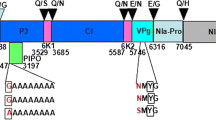Abstract
A simple, sensitive and specific RNA capture method is described for the detection of Grapevine fanleaf virus (GFLV) in infected grapevines. This method consists of hybridizing GFLV-RNAs to oligoprobes immobilized on nylon membranes, followed by RT-PCR amplification of targeted viral sequences. The RNA oligoprobe capture RT-PCR method is 10-fold more sensitive than IC-RT-PCR. The efficiency of the RNA oligoprobe capture RT-PCR and the reuse of immobilized oligoprobe membranes without loss of efficiency could make this procedure suitable for the routine diagnosis of GFLV in grapevines.
Similar content being viewed by others
Abbreviations
- GFLV:
-
grapevine fanleaf virus
- IC-RT-PCR:
-
immunocapture-RT-PCR
- RT-PCR:
-
reverse transcription PCR
References
Acheche H, Fattouch S, M'hirsi S Marzouki N and Marrakchi M (1999) Use of optimize PCR methods for the detection of GLRaV3: a closterovirus associated with grapevine leafroll in Tunisian grapevine plants. Plant Mol Biol Rep 17: 31–42.
Arnal C, Ferré-Aubineau V, Besse B, Mignotte B, Schwartzbrod L and Billaudel S (1999) Comparison of seven extraction methods on stool and shellfish samples prior to hepatitis A virus amplification. J Virol Methods 77: 17–26.
Bovey R, Gartel W, Hewitt WB, Martelli GP and Vuittnez A (1980) Maladies à virus affections similaires de la vigne. Atlas en couleur des symptômes. Eds Payot, Lausanne.
Brown DJF, Robertson WN and Trudgill DL (1995) Transmission of viruses by plant nematodes. Annual Review of Phytopathology 33: 223–249.
Caudwell A and Dalaasso A (1985) Epidemiology and vectors of grapevine virus and yellows diseases. Phytopathologia Mediterranea 24: 170–176.
Clark MF and Adams AN (1977) Characteristics of the microplate, method of enzymelinked immunosorbent assay for the detection of plant viruses. J Genl Virol 34: 475–483.
Erny C, Belin C, Esmenjaud D, Demangeat G, Pinck L and Walter B (1997) Molecular variability of grapevine fanleaf virus coat protein. Proceedings of the 12th meeting ICVG: 29–30.
Fortass M, Van Der Wilk F, Goldbach RW, Bos L and Van der Heuvel J (1996) Diversity of luteoviruses infecting faba bean (Vicia faba L) in Morocco and their detection by polymerase chain reaction. Agronomie 16: 61–68.
Fuchs M, Pinck M, Etienne L, Pinck L and Walter B (1991) Characterization and detection of grapevine fanleaf virus by using cDNA probes Phytopathology 81(5): 559–565.
Harald P, Uwe S and Hans JH (1996) Variation of viroid profiles in individual grapevine plants: novel grapevine yellow speckle viroid 1 mutants show alterations of hairpin I. J Gen Virol 77: 155–161.
Hewitt WB, Raski DJ and Goheen AC (1958) Nematode vector of soil-borne fanleaf virus of grapevines. Phytopathology 48: 586–595.
Huss B, Walter B, Etienne L and Van Regenmortel MHV (1986) Grapevine fanleaf virus detection in various organs using polyclonal and monoclonal antibodies. Vitis 25: 178–188.
Huss B, Muller S, Sommermeyer G, Walter B and Van Regenmortel MHV (1987) Grapevine fanleaf virus monoclonal antibodies their use to distinguish isolates. Phytopathology 119: 358–370.
La Notte P, Minafra A and Saldarelli P (1997) A spot-PCR technique for the detection of phloem-limited grapevine viruses. J Virol Methods 66: 103–108.
Minafra A and Hadidi A (1994) Sensitive detection of grapevine virus A, B, or leafroll associated III from viruliferous mealybugs and infected tissue by cDNA amplification. J Virol Methods 47: 175–188.
Nolasco G, De Blas C, Torres V and Ponz F (1993) A method combining immunocapture and PCR amplification in a microtiter plate for the detection of plant viruses and subviral pathogens. J Virol Methods 45: 201–213.
Olmos A, Dasi MA, Candresse T and Cambra M (1996) Print-capture PCR: a simple and high sensitive method for the detection of Plum pox virus (PPV) in plant tissues. Nucleic Acids Res 24 (11): 2192–2193.
Pearson RC and Goheen AC (1988) Compendium of grape diseases. The American Phytopathology Society, APS Press, St Paul, MN.
Raski DJ, Goheen AC, Lider LA and Meredith CP (1983) Strategies against grapevine fanleaf virus and its nematode vector. Plant Disease: 335–337.
Regan PM and Margolin AB (1997) Development of nucleic acid capture probe with reverse transcriptase-polymerase chain reaction to detect poliovirus in groundwater. J Virol Methods 64: 65–72.
Ritzenthaler C, Viry M, Pinck M, Margis R, Fuchs, M and Pinck L (1991) Complete nucleotide sequence and genetic organization of grapevine fanleaf RNA1. J Gen Virol 72: 2357–2365.
Rowhani A, Maningas MA, Lile LS, Daubert SD and Golino DA (1995) Development of a detection system for viruses of woody plants based on PCR analysis of immobilized virions. Phytopathology 85: 347–352.
Sambrook J, Fritsch EF and Maniatis T (1989) Molecular cloning. Cold Spring Harbor Laboratory, Cold Spring Harbor, NY.
Serghini MA, Fuchs M, Pinck M, Reinbolt J, Walter B and Pinck L (1990) RNA2 of grapevine fanleaf virus: sequence analysis and coat protein cistron location. J Gen Virol 71: 1433–1441.
Thomson D and Dietzgen RG (1995) Detection of DNA and RNA plant viruses by PCR and RT-PCR using a rapid virus release protocol without tissue homogenization. J Virol Methods 54: 85–95.
Walter B (1994) Le court-noué de la vigne. (I) Avantages et limites de la détection par Elisa. Le Progrès Agricole et Viticole 13–14: 320–328.
Walter B and Demangeat G (1995) Les virus du court-noué de la vigne. (II) Les voies de la contamination. Progrès Agricoles et Viticoles 112 (13–14): 295–303.
Walter B and Etienne L (1987) Detection of grapevine fanleaf virus away from the period of vegetation. Journal of Phytopathology 120: 335–364.
Walter B, Vuittenez A, Kuszala J, Stocky G, Burckard J and Van Regenmortel MHV (1984) Détection sérologique des virus du court-noué de la vigne par le test ELISA 3 Agronomie 4(6): 527–534.
Wetzel T, Candresse T, Macquaire G, Ravelonandro M and Dunez J (1992) A highly sensitive immunocapture polymerase chain reaction method for plum pox potyvirus detection. J Virol Meth 39: 27–37.
Author information
Authors and Affiliations
Corresponding author
Rights and permissions
About this article
Cite this article
Fattouch, S., M'hirsi, S., Acheche, H. et al. RNA oligoprobe capture RT-PCR, a sensitive method for the detection ofGrapevine fanleaf virus in Tunisian grapevines. Plant Mol Biol Rep 19, 235–244 (2001). https://doi.org/10.1007/BF02772895
Published:
Issue Date:
DOI: https://doi.org/10.1007/BF02772895




